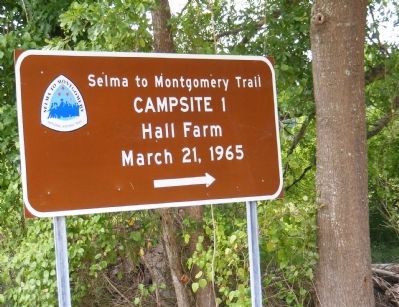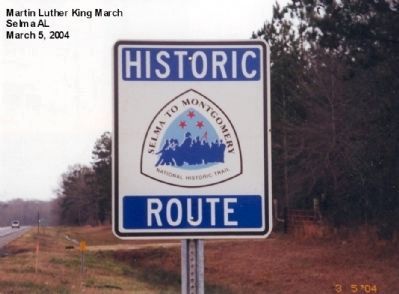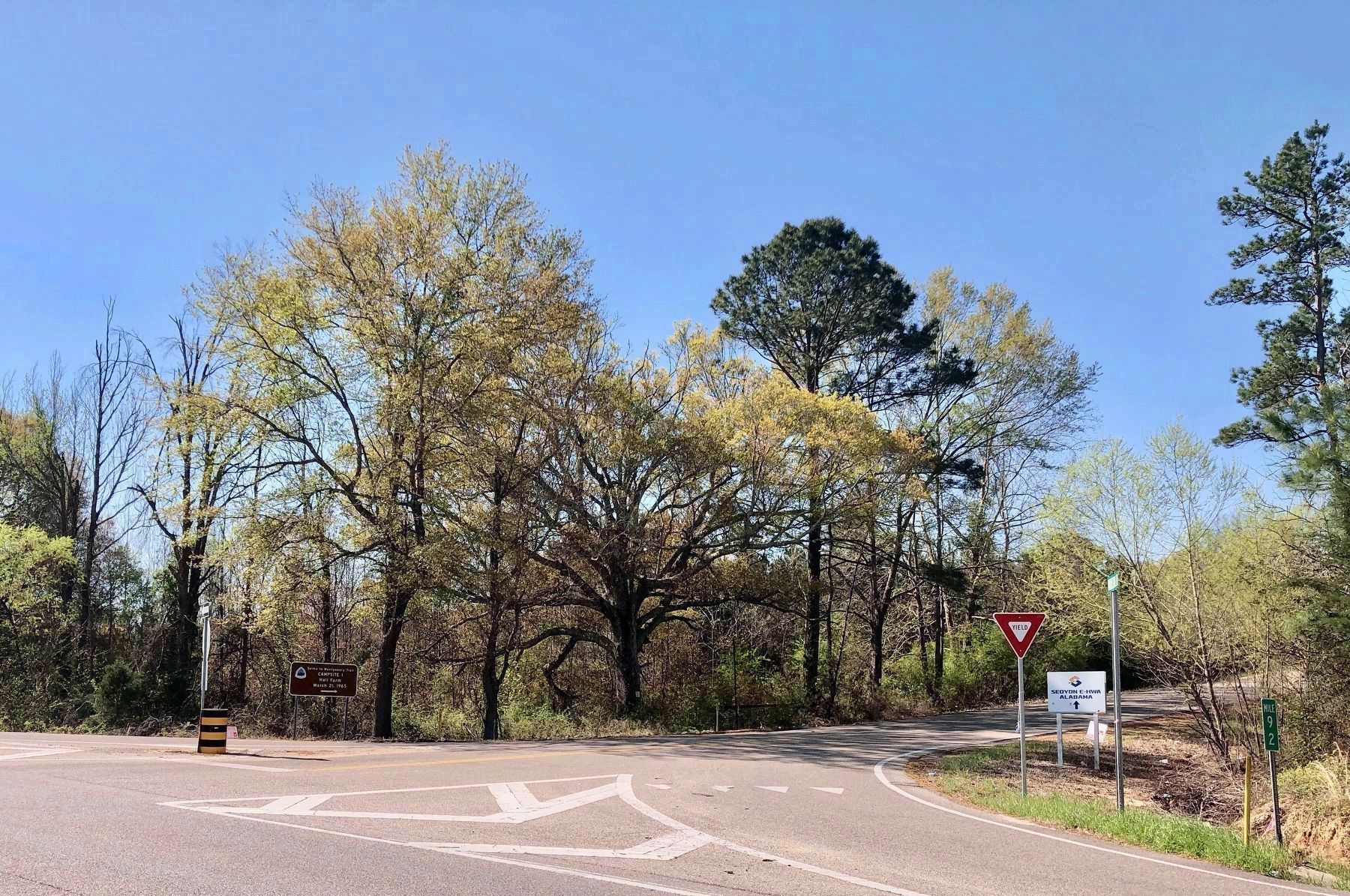Selma in Dallas County, Alabama — The American South (East South Central)
Campsite 1
Selma to Montgomery Trail
March 21, 1965
Erected by National Park Service, U.S. Department of the Interior.
Topics and series. This historical marker is listed in these topic lists: African Americans • Civil Rights. In addition, it is included in the African Methodist Episcopal (AME) Church, and the Unitarian Universalism (UUism) series lists. A significant historical month for this entry is March 1863.
Location. 32° 20.04′ N, 86° 56.868′ W. Marker is in Selma, Alabama, in Dallas County. Marker is at the intersection of U.S. 80 at milepost 92 and County Road 67 on U.S. 80. Touch for map. Marker is in this post office area: Selma AL 36701, United States of America. Touch for directions.
Other nearby markers. At least 8 other markers are within 7 miles of this marker, measured as the crow flies. Craig Air Force Base (approx. 2.8 miles away); Joe T. Pilcher, Jr. (approx. 2.8 miles away); Talisi visited by De Soto (approx. 3.9 miles away); Civil Rights Memorial Park (approx. 6.2 miles away); Lynching in America / Lynching in Selma (approx. 6.3 miles away); Honoring: Amelia Boynton Robinson - Marie Foster (approx. 6.3 miles away); The Honorable John Lewis (approx. 6.3 miles away); "Builders of Movements and Monuments" (approx. 6.3 miles away). Touch for a list and map of all markers in Selma.
More about this marker. National Park Service
Selma to Montgomery March
Until 1965, counties in Alabama used preventive measures in order to prevent African-Americans from registering to vote. Because of this, only 2% percent of the African-American population of Dallas County at that time was able to vote and 0% in Lowndes County. However, civil rights activists began to protest in Selma in order to bring attention to this injustice. These protests were often met by violence from the local sheriff's department, leaving many wondering what was going to happen next.
On the evening of February 18, 1965 during a protest to free SCLC supporter Rev. James Orange from the Perry County Jail, located in Marion, AL, Jimmie Lee Jackson was shot in the abdomen. Jackson died from his wounds on February 26.
On March 7, approximately 600 non-violent protestors, the vast majority being African-American, departed from Brown Chapel A.M.E. Church in Selma with the intent on marching 54-miles to Montgomery, as a memorial to Jimmy Lee Jackson and to protest for voter's rights. As they crossed the Edmund Pettus Bridge on March 7, they were met by a column of State Troopers and local volunteer officers of the local sheriff's department who blocked their path. The non-violent protesters were told by Maj. John Cloud that they had two minutes to return back to their church and homes. In less
than the time allotted, they were attacked by the Law Enforcement Officers with nightsticks and teargas. According to several reports, at least 50 protestors required hospital treatment. The brutality that was displayed on this day was captured by the media; however, the media was held back as the protesters retreated, where the violence continued for some time.
The attack caused outrage around the country, and March 7 became known as "Bloody Sunday". Two days later, Dr. Martin Luther King Jr. led a second march which again had its path blocked by Law Enforcement Officers. This time they decided to turn back and not risk a violent confrontation. However, that evening, three Unitarian ministers who had traveled to Selma in order to join the protest were attacked by a group of white hooligans. On March 11, Rev. James Reeb, died from his injuries.
The civil rights protestors sought and received an injunction for a third march, which was granted by Judge Frank M. Johnson, Jr. on March 17. On March 21 the official Selma to March began with the final number of supports reaching near 25,000 people on March 25. Five months later, President Lyndon B. Johnson signed the Voting Rights Act which prohibits discrimination in voting practices or procedures because of race and color.
The Selma to Montgomery National Historic Trail was created by an act of Congress in 1996. The National Park Service operates the Lowndes County Interpretive Center, the first of three planned centers. It is halfway between Selma and Montgomery and is on the site of the original “Tent City”.
Regarding Campsite 1. Published on Apr 21, 2012-You Tube
David Hall, a landowner who farmed much of his 80 acres of land located just south off Highway 80 East in Dallas County, had not taken part in the first march which resulted in what is now known as, "Bloody Sunday," but was deeply disturbed by it. Consequently, after hearing that Dr. Martin Luther King, Jr. and others organizers were planning the third Selma to Montgomery Voting Rights march and needed a place for the marchers to camp on the first night, Mr. Hall volunteered the use of his property.
Initially, accommodations for the first campsite had been promised; however, as plans were being confirmed, that property was no longer available to the organizers. This was quite devastating news to the organizers, for they understood that the march could not take place without secured lodging because the atmosphere was too dangerous for marchers to rest or stop randomly along the highway. There were few black landowners or sympathetic white landowners in the area and the majority of those were understandably too afraid for themselves and their families to participate in such a way. Needless to say, the organizers were very relieved to hear of Mr. Hall's offer to allow them to utilize his land; thus, becoming an integral part of the Civil Rights Movement.
On March 21, 1965, hundreds of marchers, en route from Selma to Montgomery, bedded down to rest at the Hall Farm in tents which occupied the hog pasture and other fields and in the barn hay loft. The marchers cleaned themselves by utilizing water from the Hall pond.
A man of modest means and little formal education, David Hall was honorable, humble, compassionate, yet, strong, courageous and God fearing. Fearing the possibility of repercussions occurring after bravely taking part in this movement, he took a stand -- depended on his faith in God to protect him from harm. Yes. Mr. David Hall faced dire consequences as a result of brazenly defying the "Jim Crow" establishment. The local bank, in which he had done business for years, froze his account, refused to do business with him and "black listed" him with other businesses, making it difficult for him to continue farming. His life was threatened and he was often visited during the late night hours by men on horseback who circled his home as a means of intimidation.
The Selma-to-Montgomery March effected great change in Alabama and the nation. President Lyndon B. Johnson signed the Voting Rights Act of 1965 on August 6, prohibiting most of the barriers that prevented African-Americans from voting.
On November 12, 1996, President Bill Clinton signed a law designating the March route as the "Selma-to-Montgomery National Historic Trail." Prior to this historic designation, the Alabama Department of Transportation requested that the route be designated as a "National Scenic By-way and All-American Road."
On August 4, 1995, Alabama governor Fob James officially signed the request, which was approved by the Federal Highway Administration in December 1995. The 54-mile Voting Rights Trail will be commemorated with interpretive centers, museums, parks, wayside panels, walking trails, and other historical markers.
In his way, Mr. Hall helped to give rise, as did many others, to the voting rights movement of 1965; and blacks are voting today in record numbers. Not in vain as his property reflects: Campsite 1 of the "Selma-to-Montgomery National Historic Trail." He is truly an Unsung Hero to his family as they continue to preserve his legacy.
--------------------------------------------------------------------------------¬--------------------
The demonstrators brought national attention to voting restrictions in Selma, and reporters from around the globe documented their progress toward Montgomery. The violent reaction they provoked quickly led Congress to pass the National Voting Rights Act in 1965. The drive literally puts you in the footsteps of the protest marchers.
Taking the route east from Selma, you cross the Pettus bridge, site of the Bloody Sunday beatings, and continue east on U.S. Highway 80, once known as the Jefferson Davis Highway, named after the Confederate President. Only a few miles outside of town, drivers see a sign marking the first campsite where marchers spent the night. It's so close because it was late in the day that marchers -- under federal protection -- finally left Selma on March 21, 1965. Exit the highway to the right, and then take a quick left to see the privately owned David Hall Farm. You can visit and it does put you in the actual footsteps of the protesters.
Related markers. Click here for a list of markers that are related to this marker.
Also see . . . Map of the Selma to Montgomery Trail. (Submitted on October 26, 2020, by Byron Hooks of Sandy Springs, Georgia.)
Credits. This page was last revised on October 27, 2020. It was originally submitted on December 15, 2012, by Don Morfe of Baltimore, Maryland. This page has been viewed 1,800 times since then and 118 times this year. Photos: 1, 2. submitted on December 15, 2012, by Don Morfe of Baltimore, Maryland. 3. submitted on March 22, 2019, by Mark Hilton of Montgomery, Alabama. • Craig Swain was the editor who published this page.


